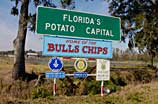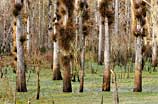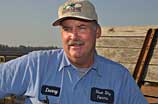Story Four - Digging in the Dirt | |
| Story One | Story Two | Story Three | Story Four | Story Five | Story Six | Story Seven | Story Eight | Story Nine | Story Ten | |
| Visit the main River Returns web site >> | |
 |
Hastings, the potato capital of Florida, is situated in the lower basin of the St. Johns River in an historically fertile niche, known as the Tri-Country Agricultural Area. The number of spud growers here have dwindled over the years, from 400 just three decades ago to 38 today. Those dusty souls who continue to plow ahead face increasing pressures from development and tougher environmental standards imposed the state. |
 |
Just to the east of the Hastings farmlands are swamps so dense that moonshiners used to make good livings here. The swamps, which border the St. Johns, play an important role in the river's health, acting as filters of nutrients and sediment from farm runoff. |
 |
Danny Johns is a 4th-generation potato grower in Hastings. Despite long days, droughts, and hurricanes, and not turning a profit for consecutive seasons, Danny can't fathom doing anything else -- except perhaps surfing once in awhile. These days, his hopes lie in a new low-carbohydrate potato that's as healthy for the river as for consumers. For the first time in a long time, he's excited about farming again. |
|
|
Danny carefully measures the pesticide that he'll spread as he plants the new potato seeds. When it comes to water quality, Danny feels agriculture has a big target on its back. But fertilizers and pesticides are expensive, Danny asserts, and farmers are a frugal lot, loath to use any more than they have to. He considers himself a good steward of the land of his grandfathers, the land of his sons. |
|
|
A conveyer transports potato seed stock from a trailer into a hold in the back of Danny's Deere tractor. Danny watches to be sure the load is even throughout the hold. |
|
|
Underscoring the cost-conscious ways of a modern grower, Danny plucks out potato seed stock that's over two-inches in length and cuts them in half to increase the number of plants he'll get in return. |
|
|
Danny's tractor is high-tech; computer calibration allows him to place seed and nutrients with precision. These seeds will get just enough fertilizer, not too much. This way, excess nitrogen isn't likely to run off into the river during storm events. |
|
|
After re-calibrating the spacing between the potato seed pieces he's planting, Danny jumps out of his tractor and into the field, measuring to check that they are 7.5 inches apart and not 8 inches. |
|
|
Pam Livingston, of the St. Johns River Water Management District, and Jody Lee, of the Florida Department of Agriculture, visit Blue Sky Farms to chat with Danny about the premier planting and harvest of the new Sunlite low-carb potato. Pam and Jody are regular visitors to farms in and around Hastings (known as the Tri-county Agricultural Area). They've embedded themselves with growers in order to promote "best management practices," voluntary actions that minimize farming's impact on the river while increasing yield and quality of crops. |
|
|
Pam Livingston and Jody Lee check on a water control structure at Blue Sky Farms, one of the recommended "best management practices" embraced by row crop growers such as Danny Johns. Constructed on a "tail-water" ditch, the water control structure is a dam-like device that maximizes irrigation efficiency and controls storm water runoff containing agricultural by-products. |
|
|
A furrow is situated between every 16 rows of potatoes on Danny's farm, to convey irrigated water to the roots of plants and help direct runoff. The use of furrows for irrigation is considered a "best management practice." |
|
|
The use of controlled-release fertilizers is an innovative "best management practice," allowing growers to feed nitrogen and phosphorus to their plants with minimal waste. If this cost-prohibitive product becomes more affordable, it stands to be adopted by more growers. |
|
|
Danny holds an old newspaper clipping, the focus of which is his great-grandfather's first horseless farm here in Hastings. Just as his great-grandfather adopted the "new-fangled" machine known as a tractor, so is Danny embracing innovation. He is a member of a cooperative of farmers who hold the patent on a brand new low-carb potato. |
|
|
Chad Hutchinson (left), an assistant professor of horticultural sciences at the University of Florida, runs the Hasting Research Farm where new crops are tested. He was instrumental in introducing the low-carb Sunlite potato to growers in the Tri-County Agricultural Area. With a faster growing time than other varieties of potato, the Sunlite requires less nutrients, pesticides, and irrigated water. Not only is it good for people, it's also good for the river. |
|
|
Bill Cotton (left), general manager of Sun Fresh of Florida marketing cooperative, shares in the excitement of Danny Johns (center) and Jody Lee (right) as Johns harvests the very first crop of low-carb Sunlite potatoes. |
|
|
In comparison tests pitting the Sunlite potato against other varieties, focus groups consistently identified the Sunlite as the tastiest spud, not to mention prettiest. That this potato has one-third less carbohydrates than other types is an added benefit, but not the main reason that a handful of Hastings growers are staking their futures on it. |
|
|
As the Jacksonville metropolitan area continues to creep southward toward Hastings, large tracts of farmland are hot commodities for developers and fetching top-dollar for financially strapped growers, many of whom haven't realized a profit for consecutive years. Farmers like Danny Johns consider themselves good stewards of the land and worry that if they leave, the impacts on the river from development will be far worse than if the land stayed in farming. |
Water's Journey
The River Returns
Stories of the Great St. Johns
The River Returns web documentary, Copyright © Fusionspark Media, Inc. All Rights Reserved.
All Photos © 2005 Russell Sparkman/Fusionspark Media, Inc., unless otherwise noted.
All Photos © 2005 Russell Sparkman/Fusionspark Media, Inc., unless otherwise noted.
